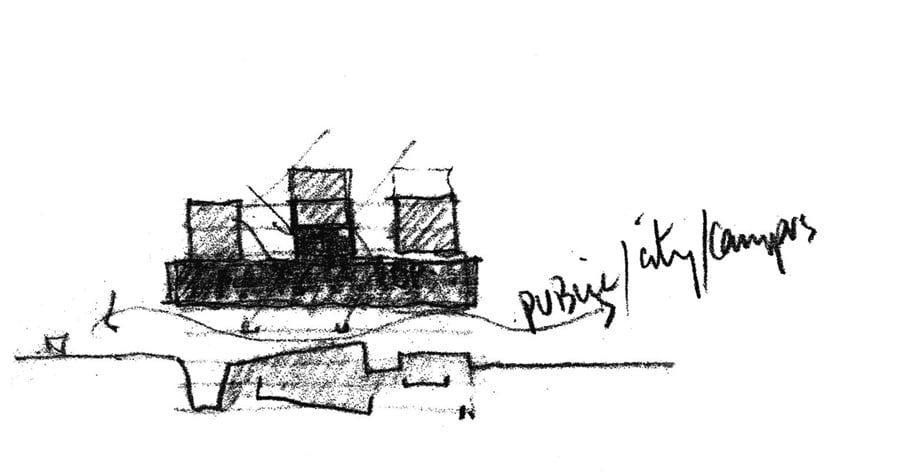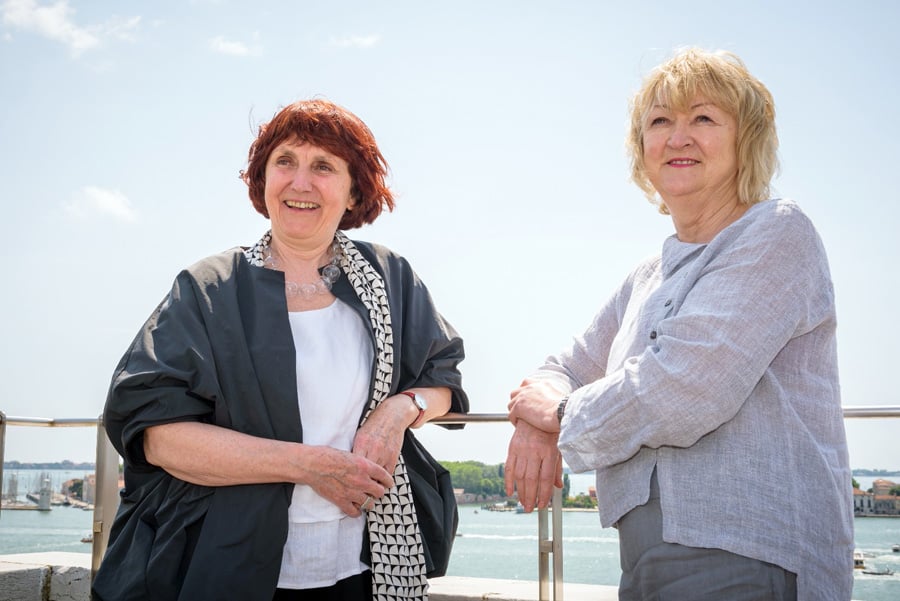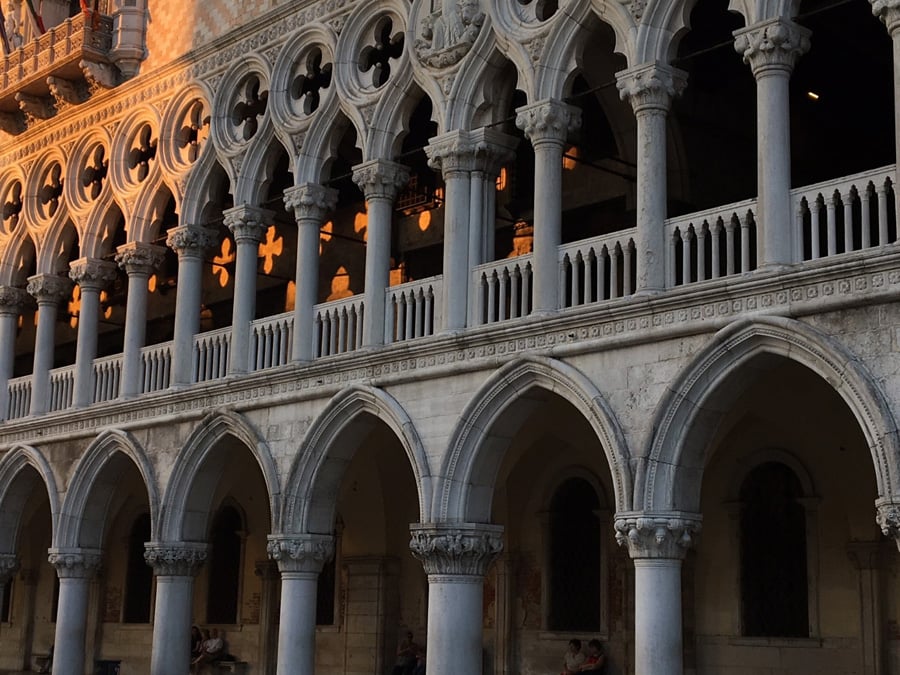
April 9, 2018
Grafton Architects’ Venice Biennale Will Celebrate Architecture’s Atmospheric Qualities
This year’s exhibition, curated by Shelley McNamara and Yvonne Farrell, promises to celebrate the more ephemeral qualities of architecture—and Venice.

The two founding principals of Dublin-based Grafton Architects, Shelley McNamara and Yvonne Farrell, are uniquely erudite in the way they talk about buildings. Interlaced with their descriptions of capital-A architecture are references to poetry, novels, and popular science. Joyce, of course, makes his way in, as do Gabriel García Márquez and, happily, the theoretical writings of architects whom McNamara and Farrell count as peers, such as Iñaki Ábalos.
The duo are the directors of the 16th edition of the Venice Architecture Biennale, which opens on May 26 and will be augmented by a slew of special programs and the national pavilion exhibits. They are calling their exhibition Freespace. It’s a term that is, fittingly, open to interpretation and that promises to build on the public-facing works, including the RIBA International Prize–winning UTEC Campus in Lima, Peru, and a school of economics in Milan, that have earned Grafton an international following. After a presentation of the biennale in New York, the architects spoke with Metropolis about the meaning of place, the “generosity” of space, and the transhistorical source of architecture’s power.
In your manifesto [for the architecture biennale], you put forward several variations on what “freespace” does without actually nailing down what it is. Can you try to do so now?
Shelley McNamara: The first thing is that nobody really knows what “freespace” means, so it’s to get people’s curiosity [piqued]. It translates beautifully into some languages. The general idea is that everybody has the right to benefit from architecture, whether it’s to do with ownership or simply enjoying the presence of a wall or an archway.
Yvonne Farrell: Architecture is quite a normal thing. Sometimes what happens is that projects are made in such a conceptual way that measuring the time it takes for somebody to walk past the outline of a building—their experience at their own pace—is not judged. In the manifesto we try to get a measure of the macro and the micro. That’s what our discipline is really responsible for, and we have to be quite assertive about that. That somebody walks, opens a door, walks past, spends time at the edge. It’s not the 19th floor [of a tower] that matters when you’re walking on the street, it’s the ground floor. It’s not zero in the States, it’s level one, is it?
Yes, that’s right. Ada Louise Huxtable famously asked her readers whether they had “kicked a building lately.”
YF: That’s nice.

I highlighted a few words from your presentation—“heroic,” “generous,” “atmospheric.” Let’s take up that last one, as it really applies to the images in your slide show, in which you showed different interiors of Venice at very specific points of the day. Why do you choose to dwell on this idea of atmosphere, and how do you hope that comes through in the exhibition itself?
SM: We approached curating this biennale as architects. We knew, because of the short timeline, we had to use the tools that we already had. And in our work, we very often start with atmosphere. For instance, in Milan [where Grafton Architects completed a building for Università Luigi Bocconi School of Economics in 2008], we were thinking about the atmosphere of moving through the solid wall of the city, which is the nature of Milan, into the friendly, light interior.
YF: We always try to really look at the place. In Venice it was the fog that was the most extreme [element] for us. When we talk about atmosphere it isn’t in terms of decor, but it’s rather the idea that atmosphere should heighten your awareness of where you are. At Toulouse [France, where Grafton is building a campus for the university’s school of economics], you look out and see the great river of the Garonne and the Canal de Brienne [converging]. There’s a medieval wall and a Romanesque church close by. You become hyperaware of place. The architecture almost becomes a kind of GPS, so that by virtue of the building and standing in it you know your coordinates on the earth.
Going back to the biennale, there’s so much information to absorb that we wanted the buildings that we were in charge of to have their own independent strength. That they weren’t just kind of a collection of exhibits, but that the buildings and their own characteristics are something that you remember, in addition to the contents they hold. We were able to see the Corderie [inside the Arsenale, the city’s old shipyard–turned–art exhibition venue] completely empty. It just seemed an awful pity that one would go to the biennale and never appreciate that. It’s such a heroic space. So what we’ve done is literally make that more present. It is incredibly powerful because of its linear form. If you think of Venice and all its intrigue—all its canals and all its different shapes—there’s this moment of clarity in the Arsenale.

Those are things I associate with your architecture—rectilinearity, clarity, strength. With Bocconi and UTEC [a university in Lima, Peru, whose campus Grafton designed in 2015], there is a physicality and weighty presence to both buildings, and they are unabashed about this. Is it right to say that these are constants in your work?
YF: It’s something that we first developed in Bocconi. We were actually doing bridges at the same time. One of the saddest moments in architectural history, we think, is when schools of architecture and engineering split. We believe that the clarity of engineering and the spatial ideas of architecture are indelibly connected to one another. With structure, there is a framework for freedom, and you can see this within UTEC. The structure allowed us to prize apart the various needs and to have circulation [pathways], which [were], if you like, akin to bridges. Students are suspended above Lima, where they’re conscious of the city but also of the campus itself. So structure became the kind of underpinning of life.
SM: We also became aware of how many contemporary buildings didn’t have that kind of ancient sense of channeling the forces of gravity. I think it was Iñaki Ábalos who wrote a very interesting essay about how architecture has lost the ability to make these great walls like [the ones] the ancients made. That seemed a territory that we would like to try to move into.
Anything is possible when you don’t have to provide for insulation or piping.
SM: But as Yvonne said, once we really started to develop the idea of how much a structure makes the space, of how little you need to do once you make a great structure, how much it can do without almost anything else, that leads you to a sense of either lightness or horizontal space or vertical space.
YF: At the same time, there are many contemporary buildings being built around the world that are very beautiful in a kind of “bony” sense. But they get wrapped and they lose their skeletal power. I suppose what interests us is that there’s some sort of synthesis between what the structure is doing and the space. At Bocconi, when the sun shines, the light dissolves this incredibly strong structure. In a sense, we discovered that light obliterates structure.
Much of that—about the joining of engineering and architecture, or the foregrounding of structure—strikes me as being somewhat Modernist, which isn’t a criticism. How far are you willing to embrace that connection, or is it more incidental to your conception of architecture?
SM: We are aware of the connection. Part of it is functional—with the LSE project [a large building for the London School of Economics], for instance, we started with light, air, water, moonlight, ventilation. It was really interesting to start with those kinds of basic themes, which lift the spirit and make you feel good. In the end, that’s the material we deal with. I remember a poet friend saying to me, “Your material is light, isn’t it?”—just as theirs is words. I just thought that was really beautiful. It sounds so simple, but the materials of architecture are free. And what do we do with them? How do we deal with the air and the wind and the rain?
YF: We are interested in the wide spectrum of architecture, from infrastructure projects down to the most minuscule one that an architect has control of. That was really the other part, to start with the basics. Architects should not forget that when people sit against a brick wall, that brick radiates heat, that there’s warmth there. Architecture, if you like, is not designed as a neutral thing.
SM: And it’s not passive—buildings can assume their own personality and settle into a place in their own way. “Houses live and die,” as François Mauriac wrote about the private house. The way you go to a building, it might be in ruins, but it has an atmosphere, and you wonder why, and others just don’t. I mean, what is that?

It’s natural for an architect to talk about their work in tactile ways or, just as usually, through devices of scale, as you previously mentioned. But it’s not as easy to do the same in the temporal register. The discourse around “ruination” is often used, as you just alluded to. Still, a point in your manifesto seems to explore an expanded notion of time. Can you elaborate on that?
YF: In one part of the manifesto, we quote a Greek proverb: “A society grows great when old men plant trees under whose shade they know they will never sit.” Things will last longer than ourselves. We live in an age of kind of instant gratification, but architecture is like slow food. It takes time to do. But it also changes its character over time. That’s not really discussed enough in depth, because people want the quick response, they want it now, and they want to have mature trees on day one.
SM: We’re really interested in that, the phenomenon of time. Yvonne, you were talking about it on the flight on the way over, a theory you were reading about recently that everything happens at once. There’s a really interesting definition of education, that knowledge is about recognizing something you already knew. T.S. Eliot speaks beautifully about that, about making the ancient more present in the future. He has a fantastic way of describing that and describing how tradition and energies of different traditions pass through different poets at different times and in different ways. The other phrase we love is from [French architect] Laurent Beaudouin, who says “architecture is a machine for slowing time down.”
The language you use to describe how one experiences architecture seems purposefully unadorned. How did you conceive of the audience for your biennale?
YF: Architecture is a total experience, not only a visual one or an intellectual one, for that matter.
OK, so the previous director, Alejandro Aravena, stressed that his exhibition was intended to be useful for architects and policy makers. Do you share that ambition?
SM: I think of [French architects] Lacaton & Vassal and how they say to “give double what you’re asked for.” They make spaces that are not programmed but invite a different kind of use.
YF: Every building, every project, is an invention. So it’s also a challenge to the profession to invent something that is not just a piece of toothpaste that you just squeeze out [of] an architectural container. It’s not an easy profession.
And how do you hope nonarchitects might benefit from visiting the biennale?
SM: It’s actually something the biennale team kept asking us—“What message do you want to give to the nonarchitect as well as the architect?” We talk about “cohesion,” and what we mean is that somebody will walk away with one or two messages. We can’t say precisely what they will be, but there’s cohesion there because [the ideas and themes in the show] are not so diverse as to be confusing. Those [takeaways] will be directed by the manifesto and by the values of the curator, and will be felt and legible.
YF: We’d like to think that the manifesto was for the nonarchitect who, in assessing, say, a local planning application would have a vocabulary where they can actually say, “What is the ‘freespace’ component of this project? What is the free gift for the stranger?” That it could be used as a weapon is probably too strong a word, but we do see it as a point of access into our profession. We’re very conscious that we are highly specialized. It’s interesting that at one level, it’s a generalist profession, but it also kind of excludes people.
We would like the manifesto to be a useful tool in itself, that it live on even after the biennale, that it become like a charter of values that people both within and outside the profession could find useful. That the citizen would have these words and have a kind of checklist of being able to look at projects and to challenge, if you like, the powers that be.
You might also like, “Getting to Know Grafton Architects, Directors of the 2018 Venice Biennale.”













